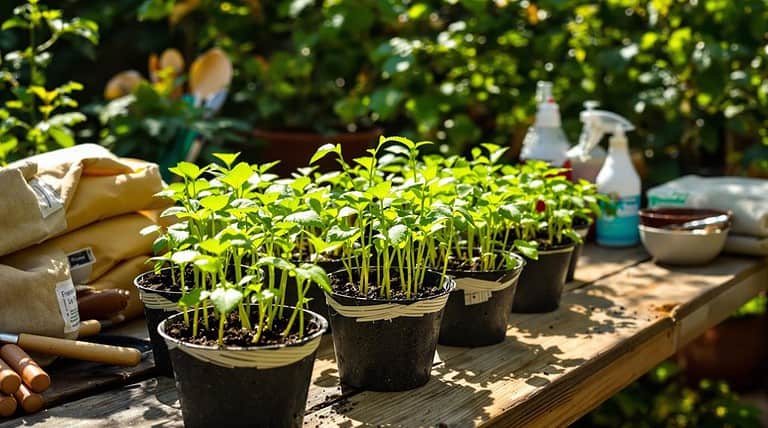Pruning a Rose of Sharon for Better Blooms
Prune your Rose of Sharon in late winter or very early spring, when buds are tight, and cut no more than a third of the shrub so you don’t shock it; I always feel like a careful barber trimming a shaggy traveler. Remove dead wood down to healthy buds, thin crowded stems to 8–12 inches for airflow, and shorten tall stems to encourage fresh, flower‑bearing side shoots. Clean tools, mulch, water and watch buds swell—keep going to learn handy tips.
TLDR
- Prune in late winter or very early spring before new shoots appear to expose structure and encourage fresh, flowering wood.
- Remove dead, damaged, or crossing branches at their base and thin interiors to maintain 8–12 inch spacing for airflow.
- Reduce overall shrub height by no more than one-third to avoid shock while stimulating vigorous regrowth and blooms.
- Make clean cuts just above healthy outward-facing buds and sterilize tools between cuts to prevent disease spread.
- After pruning, water deeply weekly, apply 2–3 inches of mulch (kept off the stem), and fertilize with a balanced slow-release in spring.
When to Prune Your Rose of Sharon
If you want your Rose of Sharon to put on a real show next summer, prune it in late winter or very early spring before new shoots appear, because that timing gives you the clean slate the shrub needs to push out lots of fresh, flower-bearing wood; I usually wait until I can see the buds are still tight and the ground’s not a muddy mess, which makes it easier to spot dead branches and avoid accidentally snipping away next season’s blooms. Prune no more than a third, remove dead wood, consider late-fall cleanup if you hate seedlings, and tweak timing for your climate—it’s honest, simple, and you’ll get bigger, bolder blooms. Also be sure to remove seed pods in fall to prevent self-sowing. Clean tools before use to prevent disease spread.
Tools and Safety for Pruning
When you’re gearing up to prune your Rose of Sharon, think of it like packing for a camping trip—bring the right gear, keep it sharp, and don’t forget the first-aid kit; I always feel a tiny thrill cleaning and organizing my tools the night before, because sharp, well-kept shears and loppers make pruning faster, cleaner, and way more fun than wrestling with dull blades.
Wear gloves, eye protection, sterilize and sharpen tools, check for rust, use ergonomic grips, keep a pocket sharpener, clear debris, and have a first-aid kit handy—safety first, happy pruning! It’s best to prune in late winter or early spring to direct energy into new growth and flowers late winter. Using quality, durable tools can save time and reduce strain, so consider investing in quality tools for long-term ease and better results.
Pruning Cuts and Techniques
Grab your shears and think of pruning Rose of Sharon like planning a great camping hike—you’re picking the best path, trimming the heavy packs, and leaving room to breathe—so let’s get into how and where to make those cuts to keep your shrub happy and blooming.
Cut just above buds, remove dead wood at the base, thin for 8–12″ spacing, and prune in late winter. Be sure to clean your shears after use to prevent spreading disease and rust, using rubbing alcohol on the blades.
Shaping for More Blooms
Think of shaping your Rose of Sharon like packing a backpack for a multi-day hike—you want to trim the bulky, worn-out gear, keep the essentials close, and arrange everything so you can move easily and enjoy the view; by pruning in late winter before new growth starts you’ll see the shrub’s true structure, remove up to a third of the height to avoid shocking it, and selectively cut back stem tips to encourage side branches that will bear next season’s flowers, which means more blooms come summer.
Now, inspect branches, thin the interior for airflow, pinch tips to spark lateral shoots, and keep stems 8–12 inches apart so sunlight feeds lots of happy buds next season. Fall is also a great time to plant shrubs because warm soils and cool air promote root growth, helping new or relocated plants establish before winter.
Managing Suckers, Seed Pods, and Spread
Let’s nip those freeloaders in the bud—suckers and seed pods are like extra hikers that crash your camping trip, stealing snacks and sleeping space from the main crew, and if you don’t deal with them they’ll turn your tidy Rose of Sharon into a crowded campsite.
You’ll want to pull or cut suckers down at the root so they don’t regrow, clip off seed pods before they scatter babies across your yard, and keep an eye on the soil around the shrub for any tiny volunteers that pop up.
Caring for the Shrub After Pruning
Now that you’ve trimmed your Rose of Sharon, you’ll want to make clean cuts and keep tools sanitized so the shrub doesn’t catch infections — I always feel a little like a camp medic when I wipe down my pruners, and it really helps new shoots stay healthy.
Give the plant a deep drink and spread mulch around the base to hold moisture and temperature, but don’t let the soil stay soggy, and if it hasn’t rained much you’ll need to top up the watering between camping trips.
Finally, fertilize with a balanced, slow‑release feed and watch new growth closely for pests or weird spots, because staying on top of things now means bigger, showier blooms later — trust me, it’s worth the effort.
Clean Cuts and Sanitation
Frequently, a quick bit of cleanup after pruning makes all the difference for your Rose of Sharon, and you’ll be glad you took the time—sharp, clean cuts heal faster and keep nasty bugs and diseases from moving in.
Wipe tools with alcohol, cut just above healthy nodes, toss diseased clippings—don’t compost—and watch branches breathe, recover, and reward you with better blooms.
Watering and Mulching
After you’ve given your Rose of Sharon a good haircut, you’ll want to babysit its watering and mulching for a little while, because plants fresh off pruning behave a bit like a camper who’s lost their map—confused and in need of steady support; water deeply about once a week, roughly the amount of an inch of rain, to encourage roots to go deep, but bump that up to twice a week or more if it’s blazing hot or the soil’s drying fast.
Mulch 2–3 inches, keep it off the stem, refresh yearly, and watch soil moisture so you don’t overdo it.
Fertilize and Monitor Growth
Fertilizing and watching your Rose of Sharon after a haircut is a bit like topping off a camper’s pantry before a big hike—you want to give it steady, reliable fuel so it doesn’t stall out mid-journey, and you’ll be glad you did when it bursts into blooms; aim to feed in early spring once the ground thaws so the roots get what they need for the season, skip fertilizers in fall (you don’t want tender new shoots that can’t handle winter), and remember that one good, balanced application a year usually does the trick unless you’re growing the shrub in a container, which behaves like a hungry backpacker and may need diluted liquid feeds during the summer.
Use a balanced slow-release fertilizer at the drip line, watch for yellowing leaves or fewer flowers, adjust amounts by shrub size, and test soil pH; be ready to trim damaged wood and tweak feeding if your plant looks stressed.
Overall
You’ve got this—prune your Rose of Sharon in late winter or early spring, wearing gloves and using sharp tools, and you’ll get brighter, more blooms all season. Cut back crossing branches, remove suckers and old seed pods, and shape the shrub to let light in; don’t be afraid to make decisive, clean cuts. After pruning, mulch and water, watch new growth, and enjoy the show—like a great camping trip, it’s payoff for smart prep.






